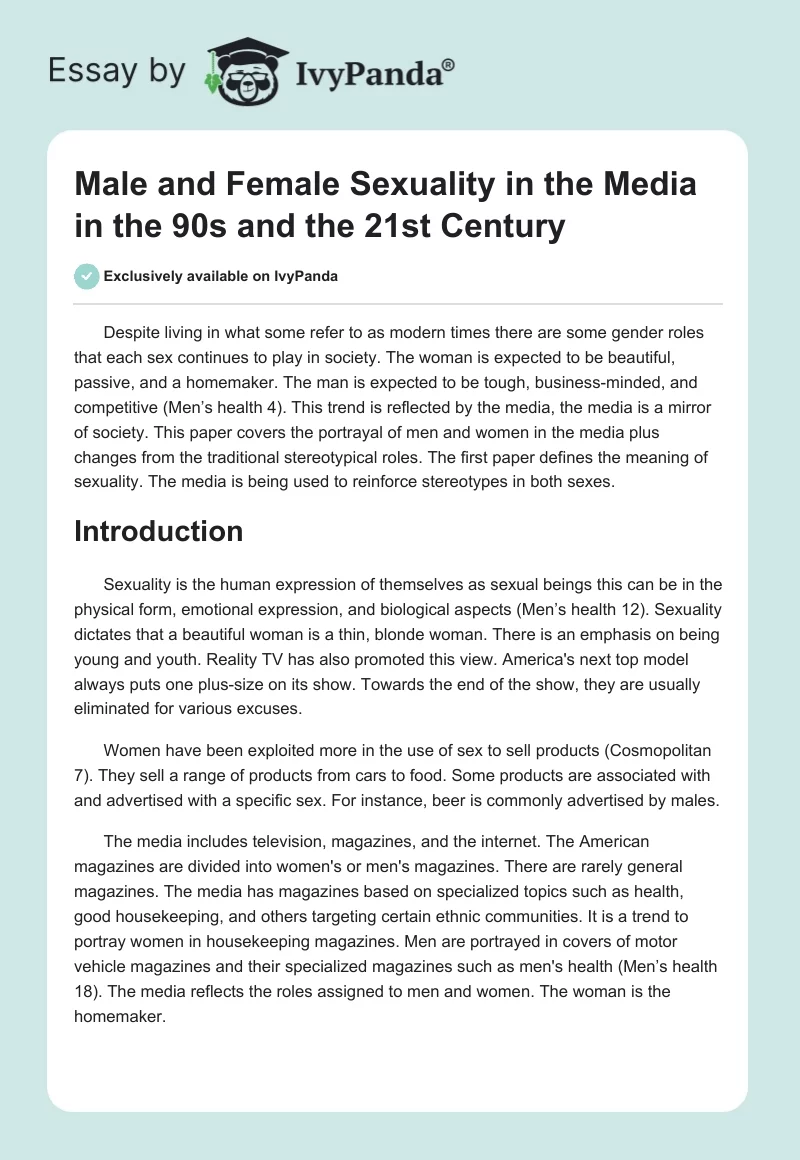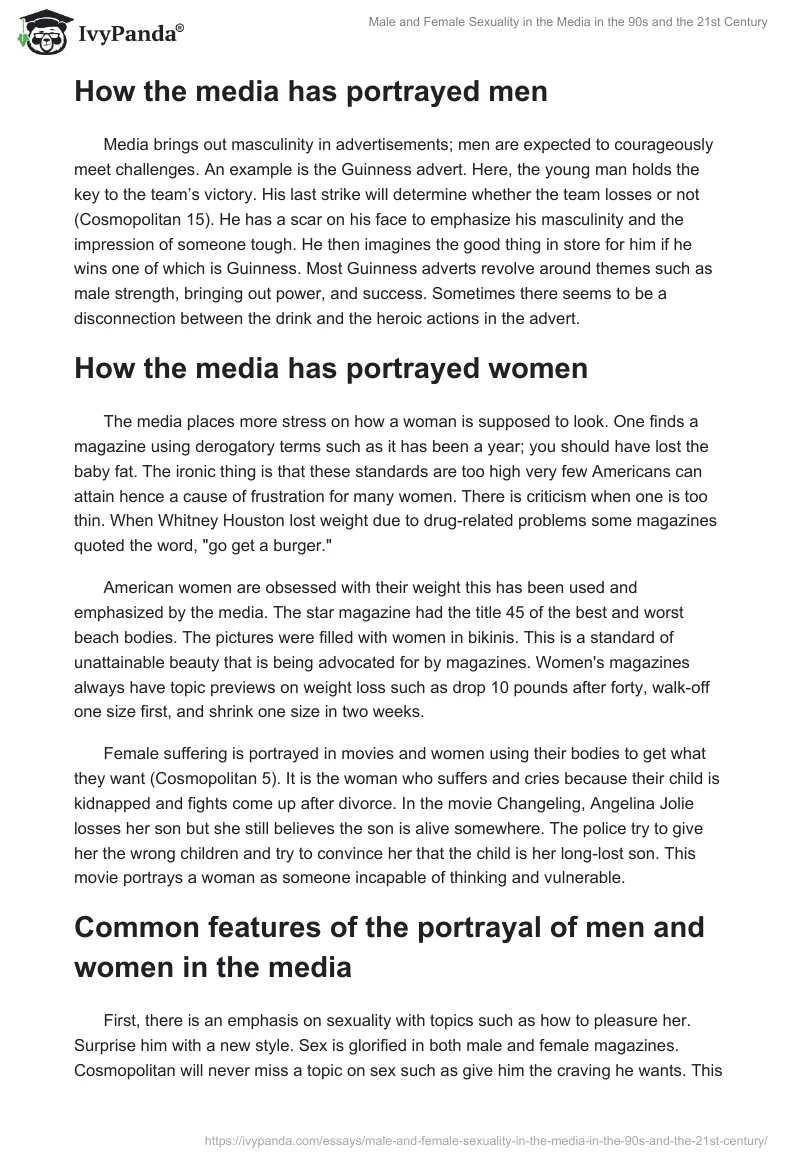Despite living in what some refer to as modern times there are some gender roles that each sex continues to play in society. The woman is expected to be beautiful, passive, and a homemaker. The man is expected to be tough, business-minded, and competitive (Men’s health 4). This trend is reflected by the media, the media is a mirror of society. This paper covers the portrayal of men and women in the media plus changes from the traditional stereotypical roles. The first paper defines the meaning of sexuality. The media is being used to reinforce stereotypes in both sexes.
Introduction
Sexuality is the human expression of themselves as sexual beings this can be in the physical form, emotional expression, and biological aspects (Men’s health 12). Sexuality dictates that a beautiful woman is a thin, blonde woman. There is an emphasis on being young and youth. Reality TV has also promoted this view. America’s next top model always puts one plus-size on its show. Towards the end of the show, they are usually eliminated for various excuses.
Women have been exploited more in the use of sex to sell products (Cosmopolitan 7). They sell a range of products from cars to food. Some products are associated with and advertised with a specific sex. For instance, beer is commonly advertised by males.
The media includes television, magazines, and the internet. The American magazines are divided into women’s or men’s magazines. There are rarely general magazines. The media has magazines based on specialized topics such as health, good housekeeping, and others targeting certain ethnic communities. It is a trend to portray women in housekeeping magazines. Men are portrayed in covers of motor vehicle magazines and their specialized magazines such as men’s health (Men’s health 18). The media reflects the roles assigned to men and women. The woman is the homemaker.
How the media has portrayed men
Media brings out masculinity in advertisements; men are expected to courageously meet challenges. An example is the Guinness advert. Here, the young man holds the key to the team’s victory. His last strike will determine whether the team losses or not (Cosmopolitan 15). He has a scar on his face to emphasize his masculinity and the impression of someone tough. He then imagines the good thing in store for him if he wins one of which is Guinness. Most Guinness adverts revolve around themes such as male strength, bringing out power, and success. Sometimes there seems to be a disconnection between the drink and the heroic actions in the advert.
How the media has portrayed women
The media places more stress on how a woman is supposed to look. One finds a magazine using derogatory terms such as it has been a year; you should have lost the baby fat. The ironic thing is that these standards are too high very few Americans can attain hence a cause of frustration for many women. There is criticism when one is too thin. When Whitney Houston lost weight due to drug-related problems some magazines quoted the word, “go get a burger.”
American women are obsessed with their weight this has been used and emphasized by the media. The star magazine had the title 45 of the best and worst beach bodies. The pictures were filled with women in bikinis. This is a standard of unattainable beauty that is being advocated for by magazines. Women’s magazines always have topic previews on weight loss such as drop 10 pounds after forty, walk-off one size first, and shrink one size in two weeks.
Female suffering is portrayed in movies and women using their bodies to get what they want (Cosmopolitan 5). It is the woman who suffers and cries because their child is kidnapped and fights come up after divorce. In the movie Changeling, Angelina Jolie losses her son but she still believes the son is alive somewhere. The police try to give her the wrong children and try to convince her that the child is her long-lost son. This movie portrays a woman as someone incapable of thinking and vulnerable.
Common features of the portrayal of men and women in the media
First, there is an emphasis on sexuality with topics such as how to pleasure her. Surprise him with a new style. Sex is glorified in both male and female magazines. Cosmopolitan will never miss a topic on sex such as give him the craving he wants. This also applies to male-targeted magazines such as Men’s Health (Men’s health 10). The pressure to look a certain way has spread to the men. They are expected to be like wrestlers and sportsmen who are featured in their magazines. These men act as role models for men and inspire the men to take up exercise regimes that will make them look like that. It is common to find men pinning posters of their heroes in their rooms.
There are often topics on how to get a certain look, for men it is how to get muscular. For women, the topic is on how to lose weight. In men, there are tips on how to become more muscular. Men’s Health magazine offers advice on how to build muscle, burn fat, and change the attitude in ten weeks (Men’s health 19).
The media has overinflated differences between men and women. With common terms such as ‘Men are from mars and women are from Venus.’ The magazines try to make men and women understand each other. This trend is negative because one goes into a relationship expecting a battlefield rather than living harmoniously and celebrating our differences (Cosmopolitan 21). There is pressure from male and female magazines on the role of each sex to make relationships work. They both contain dating advice and how to attract the opposite sex. In men’s health magazine you find topics like six ways to make a first impression.
Changes from the traditional stereotypical roles
There are changing trends from the traditional roles expected of men and women in the media. Due to feminism movements and other groups advocating for women, the changes of roles of women and men in society are changing. Men’s magazines contain articles on roles that are traditionally for the woman. The April issue on Men’s health contains the article, ‘Cooking skills for guys.’
There is a change in the way men are being portrayed. Earlier men have been portrayed as the head of the home. Now women are being portrayed as the head of the home using manipulative ways to control men. An example is my wife and kids, the wife shuts up the husband when he is speaking in front of the children. She also makes him do household chores and denies him sex to get what she wants (Cosmopolitan 17).
Men are also being portrayed more sexually provocatively. They have lesser clothes with certain body parts being emphasized. There is a trend of placing men who are weak and eager to please women. An example is a series Ugly Betty where Venus Williams uses her spineless assistant to do her shoddy jobs. He seems to lack a mind of his laughing at her boring jokes just to please her.
Women are being portrayed in positions of power and people who are independent. For instance, in the advert on Pepsi where Beyonce and Jennifer Lopez use Kung fu moves to get to drink the Pepsi drink (Cosmopolitan 25). This shows that women can defend themselves and do not always have to rely on men. Another advert showing women empowerment is the Boddingtons advert. In this beer advert, the man pours her an imaginary Boddington beer which she takes. She gets sexually satisfied then turns and sleeps. This advert differs from the traditional beer adverts where women take subordinate roles like serving the beer or nagging the man.
More movies are delegating women powerful roles where women are fighters and do not need women to defend them. The movie Charlie’s angles portray three powerful women who manage to fight men who disturb them with unwanted sexual advances (Men’s health 7). The action pact movie emphasizes that men are as strong as women. The series 24 had an entire season with a woman president. She worked well under pressure and was a competent commander in chief. She also retained her positive female roles like being a good mother and wife.
Unfortunately, when a woman is portrayed as strong and independent, some movies always have a way of mocking her success. This is done by portraying the woman to be over-controlling or using evil means to attain power. In the series Ugly Betty, Venus Williams is seen to be using schemes such as sabotaging her colleagues to get promotions and attain power.
A hard-working stay-at-home mum is being portrayed in movies reflects the traditional role of a woman. The ironic twist is that they are being left by their husbands when they reach their 40s for younger men (Men’s health 11). The women become vengeful and try to get back at their husbands for such betrayals. An example is a movie, the first wives clubby actresses Bette Midler, Goldie Hawn, and Diane Keaton. These women make a revenge plan where they cause a husband financial ruin. Unfortunately, the revenge does not cause them much satisfaction.
Conclusion
The consistent portrayal of women in negative stereotypical roles is a step backward, against gains made by women. Women are entering careers that were previously male-dominated and they entering politics and government. The trend of male-bashing should also stop because empowerment is not a battle between the sexes. There should be more roles where men and women are celebrating the differences. For instance, there should be the portrayal of a strong career woman with a man who does not feel intimidated by her success (Cosmopolitan 22).
The emphasis on how men and women should look should also change. Society is bringing forth a generation with low self-esteem and a negative body image due to pressure from the media. The over glorification of youth should also stop because one thing is for certain you will never be forever young.
Works cited
Cosmopolitan. “Women’s magazine for Fashion, Sex advice, Dating tips, and Celebrity news.” US: Hearst Communications, Inc. 2010.
Men’s health. “Mens Guide to Fitness, Health, weight loss, Nutrition, Sex, Style and Guy Wisdom.” NY: Rodale Inc. 2010.


